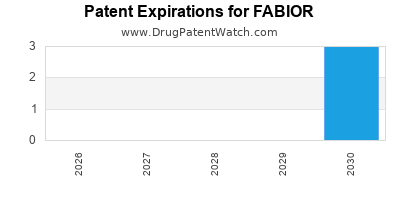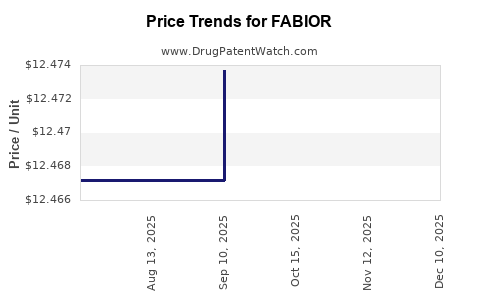FABIOR Drug Patent Profile
✉ Email this page to a colleague
Which patents cover Fabior, and when can generic versions of Fabior launch?
Fabior is a drug marketed by Mayne Pharma and is included in one NDA. There are three patents protecting this drug.
This drug has twenty-four patent family members in eighteen countries.
The generic ingredient in FABIOR is tazarotene. There are eight drug master file entries for this compound. Nine suppliers are listed for this compound. Additional details are available on the tazarotene profile page.
DrugPatentWatch® Litigation and Generic Entry Outlook for Fabior
A generic version of FABIOR was approved as tazarotene by SUN PHARMA CANADA on April 3rd, 2017.
AI Deep Research
Questions you can ask:
- What is the 5 year forecast for FABIOR?
- What are the global sales for FABIOR?
- What is Average Wholesale Price for FABIOR?
Summary for FABIOR
| International Patents: | 24 |
| US Patents: | 3 |
| Applicants: | 1 |
| NDAs: | 1 |
| Finished Product Suppliers / Packagers: | 2 |
| Raw Ingredient (Bulk) Api Vendors: | 89 |
| Clinical Trials: | 1 |
| Patent Applications: | 4,729 |
| Drug Prices: | Drug price information for FABIOR |
| Patent Litigation and PTAB cases: | See patent lawsuits and PTAB cases for FABIOR |
| What excipients (inactive ingredients) are in FABIOR? | FABIOR excipients list |
| DailyMed Link: | FABIOR at DailyMed |


Recent Clinical Trials for FABIOR
Identify potential brand extensions & 505(b)(2) entrants
| Sponsor | Phase |
|---|---|
| Actavis Inc. | Phase 3 |
Pharmacology for FABIOR
| Drug Class | Retinoid |
US Patents and Regulatory Information for FABIOR
FABIOR is protected by three US patents.
| Applicant | Tradename | Generic Name | Dosage | NDA | Approval Date | TE | Type | RLD | RS | Patent No. | Patent Expiration | Product | Substance | Delist Req. | Exclusivity Expiration |
|---|---|---|---|---|---|---|---|---|---|---|---|---|---|---|---|
| Mayne Pharma | FABIOR | tazarotene | AEROSOL, FOAM;TOPICAL | 202428-001 | May 11, 2012 | RX | Yes | Yes | 10,568,859 | ⤷ Get Started Free | Y | ⤷ Get Started Free | |||
| Mayne Pharma | FABIOR | tazarotene | AEROSOL, FOAM;TOPICAL | 202428-001 | May 11, 2012 | RX | Yes | Yes | 10,688,071 | ⤷ Get Started Free | Y | ⤷ Get Started Free | |||
| Mayne Pharma | FABIOR | tazarotene | AEROSOL, FOAM;TOPICAL | 202428-001 | May 11, 2012 | RX | Yes | Yes | 8,808,716 | ⤷ Get Started Free | Y | ⤷ Get Started Free | |||
| >Applicant | >Tradename | >Generic Name | >Dosage | >NDA | >Approval Date | >TE | >Type | >RLD | >RS | >Patent No. | >Patent Expiration | >Product | >Substance | >Delist Req. | >Exclusivity Expiration |
International Patents for FABIOR
See the table below for patents covering FABIOR around the world.
| Country | Patent Number | Title | Estimated Expiration |
|---|---|---|---|
| Eurasian Patent Organization | 201171079 | ПЕНООБРАЗУЮЩАЯ КОМПОЗИЦИЯ ДЛЯ МЕСТНОГО ПРИМЕНЕНИЯ | ⤷ Get Started Free |
| Singapore | 173563 | ⤷ Get Started Free | |
| World Intellectual Property Organization (WIPO) | 2010096868 | ⤷ Get Started Free | |
| Australia | 2010217190 | ⤷ Get Started Free | |
| Japan | 2012518662 | ⤷ Get Started Free | |
| >Country | >Patent Number | >Title | >Estimated Expiration |
Supplementary Protection Certificates for FABIOR
| Patent Number | Supplementary Protection Certificate | SPC Country | SPC Expiration | SPC Description |
|---|---|---|---|---|
| 0031058 | 98C0008 | Belgium | ⤷ Get Started Free | PRODUCT NAME: TAZAROTENE; NAT. REGISTRATION NO/DATE: NL22604 19970922; FIRST REGISTRATION: DE - 37393.00.00 19961203 |
| 0284288 | SPC/GB98/002 | United Kingdom | ⤷ Get Started Free | PRODUCT NAME: TAZAROTENE : ETHYL 6-(2-(4,4-DIMETHYLTHIOCHROMAN-6-YL) ETHYNYL) NICOTINOATE; REGISTERED: DE 37393.00.00 19961203; DE 37393.01.00 19961203; UK 00426/0097 19970730; UK 00426/0096 19970730 |
| 0284288 | 12/1998 | Austria | ⤷ Get Started Free | PRODUCT NAME: TAZAROTENE; NAT. REGISTRATION NO/DATE: 1-22102, 1-22103 19970918; FIRST REGISTRATION: DE 37393.00.00, 37393.01.00 19961203 |
| >Patent Number | >Supplementary Protection Certificate | >SPC Country | >SPC Expiration | >SPC Description |
Market Dynamics and Financial Trajectory for FABIOR (Tildrakizumab)
More… ↓
Make Better Decisions: Try a trial or see plans & pricing
Drugs may be covered by multiple patents or regulatory protections. All trademarks and applicant names are the property of their respective owners or licensors. Although great care is taken in the proper and correct provision of this service, thinkBiotech LLC does not accept any responsibility for possible consequences of errors or omissions in the provided data. The data presented herein is for information purposes only. There is no warranty that the data contained herein is error free. We do not provide individual investment advice. This service is not registered with any financial regulatory agency. The information we publish is educational only and based on our opinions plus our models. By using DrugPatentWatch you acknowledge that we do not provide personalized recommendations or advice. thinkBiotech performs no independent verification of facts as provided by public sources nor are attempts made to provide legal or investing advice. Any reliance on data provided herein is done solely at the discretion of the user. Users of this service are advised to seek professional advice and independent confirmation before considering acting on any of the provided information. thinkBiotech LLC reserves the right to amend, extend or withdraw any part or all of the offered service without notice.
